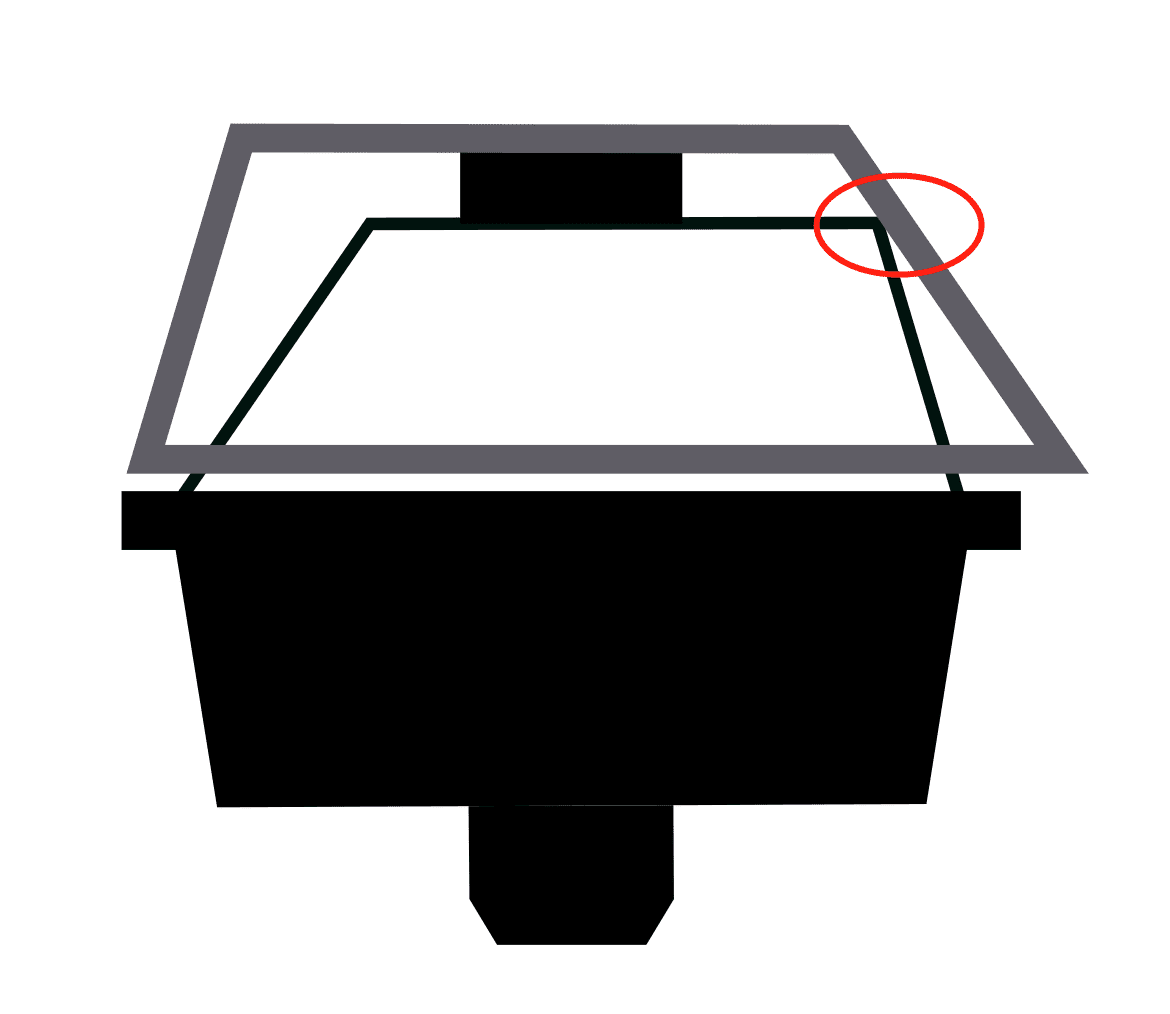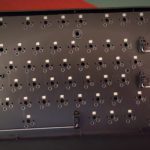
Stop Bitchin’ About North Oriented LEDs
Introduction
There are a lot of “influencers” in the keyboard community that complain any chance they get about keyboards that have the LEDs installed in the north side of the switch socket (see the little white squares in the cover photo). One literally titled his review of one keyboard “This board is almost perfect, EXCEPT” with the text in the thumbnail image reading “$60, but a fatal flaw.” That “fatal flaw”? North oriented LEDs.
Another recently whinged in a video “[…] I wear the North Face, I don’t want this in my keyboards… What the hell. I still have to build this?”
[Author’s Note: I am not calling out these creators. I am just using their statements as illustrations of the kind of non-useful comments that are reinforcing what I believe is a bad take. I am not trying to start a war with anyone, hence I am not naming the creators, or providing links to their videos. I honestly have nothing against them, and I generally like and watch their content.]
Well, I am here to say that demanding south oriented LEDs is wrong. In fact that demand ignores the real issue, and, there is literally a zero chance that manufacturers are going to switch to south oriented LEDs as it would be bad for them. And if all of that weren’t enough, there are things that the custom keyboard community should be focusing on that would be much more beneficial to all keyboard users (not just the enthusiasts).
Understanding The Market
The first step to understanding why north oriented LEDs aren’t the issue, and why they will never go away is to understand the mechanical keyboard market. Not just the enthusiast / hobbyist market, but the whole market. In order to do this, it’s necessary to take a step back, and look at the overall business of keyboards, or in this case, of mechanical keyboards. When I started getting more interested in mechanical keyboards, I started asking myself a question: is there a “mechanical keyboard market”? That might seem like a strange question, but if you look at sites like Newegg or Amazon, while they do have mechanical keyboard sections, they often overlap it with either “peripherals” or “gaming” categories.
A quick search turned up literally dozens of market research and forecast documents. Instead of referencing all of the documents here, I’ll include a list of a few of the interesting documents at the bottom of this article. There are a few key take-aways from these documents that are worth noting:
- Current market size is ~$1BN USD.
- The market forecast is that it could grow as large as $3.6BN USD within the next 8-10 years.
- Linear switches offer the most “opportunity”.
- The market segments are Gaming, Productivity / Business and Industrial.
- Most cited companies are: Logitech, Steel Series, HyperX, Razer Inc., Corsair, Lenovo, HP, ROCCAT GmBH, Rapoo Corporation, A4TECH, Cherry and several others.
This should be a somewhat sobering set of facts for most of the influencers and enthusiasts. Note that the key market segments are Gaming and Productivity / Business. There wasn’t one of these documents that I looked at that mentioned an “enthusiast” market segment. This means that enthusiasts are basically a statistical anomaly in the $1-3.6BN overall market.
The companies that came up consistently were really in two markets: PC computer manufacturing / OEMs (HP, Lenovo), or peripheral companies (Steel Series, HyperX). The only company that is primarily concerned with keyboards that came up in a few reports was Cherry, and one report mentioned Das Keyboard.. Not even companies like Leopold, Durgod, Unicomp, etc. were mentioned. And the Chinese companies like Royal Kludge, havit, Velocifire, E-Yooso, Redragoon, etc. weren’t mentioned. [Author’s Note: I seem to recall one report mentioning one or two of the Chinese companies, but I can’t remember which report or which companies.]
The last two things I’d make clearer: Gaming was the single largest market segment in all of the reports I looked at. And several of the reports pointed to linear switches as the big opportunity. I think these two points go hand-in-hand. Gamers seem to most frequently like using linear switches. The rest of the market likes tactile and clicky switches. There is more opportunity in linear switches because it is most attractive to the largest segment of the market.
How Does This Relate to RGB / LEDs?
I think it’s safe to say from the market research reports that gaming is the largest market for mechanical keyboards, and it is driving the industry now. But why does that mean north oriented LEDs won’t be going away? Well, I think it’s pretty easy to understand why if you look at Amazon or Newegg‘s keyboard listings.
The gaming market loves RGB. Just look at the videos on Linus Tech Tips, Gamer’s Nexus, or Hardware Unboxed to get an idea of how much RGB there is. And, if that wasn’t enough, just go and look at the listings for pre-built gaming systems: unicorn rainbow puke everywhere! Mechanical keyboards aren’t immune to this, especially with the gaming market being the predominant market.
If a keyboard is going to be attractive to the gaming market it has to have RGB, and it has to be very visible. And I mean very, very visible with shine through keycaps. On Amazon on the first page of the results (sorted by most popular), I count twelve keyboards with shine through keycaps. On Newegg (sorted by best selling) it’s even more: seventeen keyboards with shine through keycaps.
And this is where things start to come together. Most of the keycaps these boards are Cherry, DSA or OEM profile. And they have their legends on the upper left side of the keycap, or sometimes centered along the top edge of the keycap. And that is why north oriented LEDs are not going away. The shine through quality would not be the same if the LEDs were moved to the bottom site of the key switch mount. Doing this would mean that the light would not shine through the keycaps as evenly, and therefore the product would be less appealing to gamers.
And, you have to be honest: the gaming market is driving what companies are producing. The gaming market is where the money is. Any company that produced a product with inferior lighting effects on their keyboard for the gaming market would be committing suicide.
Bu-bu-but…
Now that we have a picture of the market, we can look at the issue itself as characterized by many mechanical keyboard enthusiasts. The problem is known as “interference” and it really comes down to a simple issue: when a key switch is oriented to allow LED light to pass through the top side to the switch sometimes key caps will strike the edge of the switch housing. Here is a pair of images I found on the makerdiary project‘s git repository (images by Yihui Xiong) that depict the problem more clearly:
Now, this issue doesn’t happen with all switches, or all key caps. In fact, we can compare the key cap profiles, and see there are two or three of them that may have this issue (image from this Reddit post):

Based on this image, it’s generally the OEM and Cherry profile key caps that are most likely to suffer from the “interference issue” when switches are installed for north oriented LEDs. In a few cases people have mentioned DSA key caps as having the issue as well. However, it doesn’t happen with all keycaps, not even all Cherry profile or DSA profile keycaps have this issue. So what is the difference? And how should it be handled?
The issue seems to come down to the thickness of the keycaps. I haven’t encountered any OEM, Cherry or DSA profile keycaps with this issue. The thickest OEM / Cherry profile keycaps in my collection are about 1.4mm thick, and as I have tested, I am able to insert a 0.5mm feeler gauge between the switch and keycap, even in the north oriented LED configuration.
So, I think this defines the problem a bit better. It seems to happen mostly with Cherry profile keycaps, sometimes with OEM or DSA profile keycaps, and when the keycaps are more than 1.4mm thick. So what are the solutions:
Solution One: Thinner Keycaps
Yes, this is probably a controversial solution. I realize there is a lot of allegiance to a certain company that produces thick keycaps. And I don’t disagree with the better materials and machining that is used in producing their keycaps. (However, pricing and production are another issue that I won’t go into here. No need to start a second controversy today…:grin:)
Now you might think that a thinner keycap would make for a different sound. However, I would say that it doesn’t really affect the sound when we are talking about a very small change in the thickness. I mentioned above that I was able to get a 0.5mm feeler gauge in the gap with a 1.4mm thick key cap. And, there was no binding – I probably could have gone a bit thicker. So the amount we are talking about here is really, a 1.45mm thick keycap would work with switches in either orientation, without affecting the sound of the keycap.
Solution Two: Switch Housing Changes
This is the one that I think is more doable, and in fact has already started to happen.
The reason for the switch housings having the shape that they have is a leftover from when the LED’s had to be installed as part of the housing. While that requirement has gone away, many of the switch manufacturers did the minimum needed to change the shape of their switch housing. This has left a significant protrusion in the top of the housing where there doesn’t need to be one now.
Updating the shape of the switch housing to work with north oriented LEDs, and thicker Cherry/OEM profile keycaps is the way to go. Why? the switch manufacturers are in the middle of this situation, and they want to have the greatest compatibility with all configurations of keyboards.
And, we are already seeing this. Several manufacturers are now listing their switches as being compatible with “SMD configuration” keyboards (which is their way of saying the switches word in both orientations). And all it took was rounding off the top corner of the switch housing to allow clearance for all keycaps.
Conclusion
Hopefully this discussion has put the actual issue into a different perspective for people. The fact is, north oriented LEDs are not going away, ever. There’s too much investment in RGB in the market for any company to ignore the desirability of north oriented LEDs. Ignoring the demand would be tantamount to committing business suicide.
There are two other solutions: slightly thinner keycaps, and modifying the shape of the switch housing. As things stand, we are starting to see the switch houses change shape a bit to be compatible with the widest array of PCB configurations. Which makes sense as the switch side of the market is possibly one of the most to gain or lose at this point. It’s pretty obvious that if the switches aren’t designed for the broadest range of applications, then it’s likely they will not be used as often (or be able to strike deals with the keyboard manufacturers) which would result in lost market share.
So stop bitchin’ about the LED configuration. It isn’t a simple issue, and no amount of complaining is going to change it. Instead focus on things that can actually fix the problem, such as the switch housing design. And, if you really want to focus on something, let’s work on getting broad acceptance of QMK / VIA in the general market. That would benefit consumers a lot more.
References
Here’s a list of some of the market research / forecast documents I used in researching this article. Not that there appears to be a wide variation between the documents. I attribute the variances to a few factors. First is timing: some of these reports are only produced every few years, so some are from 2018 or 2019, before the pandemic and the rise of work-from-home scenarios. Another factor is that some of them don’t cover all of the global regions, some focus on Asia Pacific, North America, the EU, or some combination thereof. And finally there are differences in the way each of these companies gather their data to produce the statistics in their reports. And just how they go about gathering this information is often a heavily guarded secret as it forms the basis for competition between these companies.
But, even given the variances, I think there were enough clear things that emerge from these reports that it’s worthwhile to pay attention to them. And, I think the inferences that I was able to gather about the market.
- Mechanical Keyboard Market Report: Information By Product Type (Market Research Future)
- Mechanical Keyboard Market (Future Market Insights)
- Mechanical Keyboard Market by Type […] Global Opportunity Analysis and Industry Forecast, 2022-2029 (Allied Market Research)
- Global Mechanical Keyboard Market Forecast Size, Share, Opportunities, And Trends By Applications[…] (Knowledge Sourcing Intelligence)
- Mechanical Keyboard Market: Global Industry Analysis and Forecast (2021-2027), Technology Trends, (Maximize Market Research, PVT LTD)







